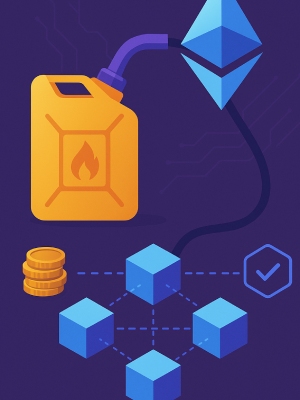What is Ethereum Gas?

Gas, in a way, is actually the unit of measurement in the Ethereum world for computational effort to carry out operations on the network: this can be a transaction, deploy a smart contract, or run any function inside an existing smart contract. Gas is not a crypto in and of itself but rather a fee to ensure that transactions and operations are finalized by the Ethereum blockchain.
To understand gas better, let's imagine Ethereum as a machine that, at every instance, performs certain actions-be it sending money, executing a contract or performing operations through a dApp. It requires energy to perform these operations. Gas acts as the fuel for this machine. Without gas, the network would either not fulfill its purpose or fall short in doing so.
The Role of Gas in Ethereum
Since the network is open and decentralized, it enjoys the absence of any central authority or entity controlling it. A network of nodes (computers) helps in validating transaction and executing smart contracts. These nodes need incentives to perform their functions well and maintain the health of the system. Therefore, gas fees incentivize miners (in Ethereum's PoW model) or their counterparts validators (in the Ethereum 2.0 PoS) to complete their work.
On the Ethereum blockchain, each operation requires a certain amount of computations. For example, it may require less gas to send Ether from one wallet to another than it could take to deploy a complex smart contract. In general, the amount of gas required increases with the computing complexity of the action. Hence, more complex tasks or operations consume more gas in comparison.
Gas and Its Calculation
The Ethereum gas fees are calculated with respect to two primary considerations: Gas Limit and Gas Price.
Gas Limit
The gas limit is basically the maximum amount of gas that the sender is willing to pay on any transaction or operation. Ether transfers have relatively low gas limits since the operations are very straightforward. Interacting with a smart contract could have a higher gas limit because the operation might be more complex and would require more computation.
Gas Price
Basically, the gas price is how much Ether you pay for one unit of gas. Generally, it is in Gwei; a value much smaller than that of Ether. The price changes depending on the network demand. It is expected to scale higher if the congestion increases, thereby giving precedence to one's transactions. For example:
- Gas Limit: 21,000 units (typically for simply transferring ETH)
- Gas Price: 100 Gwei (what you are ready to pay for each unit of gas)
When you multiply the two, you achieve the value of the gas fee for the particular transaction in Gwei.
Total Gas Fee = Gas Limit x Gas Price = 21,000 x 100 = 2,100,000 Gwei.
This can get converted into Ether, the actual value the gas represents in Ether, since 1 ETH = 1,000,000,000 Gwei.
Why Gas Fees Vary
Gas fees are dynamic. At times, they change depending on how much congestion there is in the network. For instance, during a period of high congestion due to a large number of transactions or dApp interactions, the gas price rises. The reason for this is that users would like for their transactions to be processed fast, and so must pay more; miners/validators give precedence to transactions that pay more.
To counter this, Ethereum allows users to set their own gas price. High gas prices equal quick transactions, whereas transactions with low gas prices may have to wait or fail in case they are not processed on time.
Gas and Ethereum's Transition to Proof of Stake
One great change viewed in the development of Ethereum is its transference from PoW to PoS - an upgrade set forth in the interests of minimizing energy usage and maximizing transaction throughput. Gas fees are, thus another factor affected by such an upgrade called Ethereum 2.0.
For Ethereum 2.0, the network will gain in efficiency, so it may translate to lower gas prices further down the line. This is because Proof of Stake transaction processing allows for quicker and more efficient asset transfers; however, gas prices will still be dependant on demand from the network. Ethereum 2.0 additionally proposes the invention of sharding, breaking the monolithic structure of the network into much smaller pieces (shards) that operate concurrently on transactions for better scalability and lighter congestion.
Layer 2 Solutions and Gas Fees
While Ethereum 2.0 aims at the big picture to gas fees, Layer 2 solutions are being deployed in real-time to ensure the adverse effect on the users today is minimized. Layer 2 is a technology stack that rests on top of the Ethereum network with an eventual goal of preventing congestion and scaling the system more efficiently.
Solutions such as Optimistic Rollups and zk-Rollups deposit a batch of transactions into the Layer 2 network before being ultimately submitted onto the Ethereum main chain. They, thus, reduce raw throughput on Ethereum, consequently lowering gas fee incentives for users.
Summary
The concept of gas fees is inherently tied to the Ethereum network such that fees serve the purpose of rewarding miners or validators to execute transactions or smart contracts. Gas fees may vary due to network activity, but knowing how gas works, gas limits, gas prices, and total costs can serve users well in managing the costs. Between Ethereum's shift towards Proof of-Stake and the rising Layer-2 solutions, there is hope for those inconsistencies to disappear and the fees to be largely diminished.